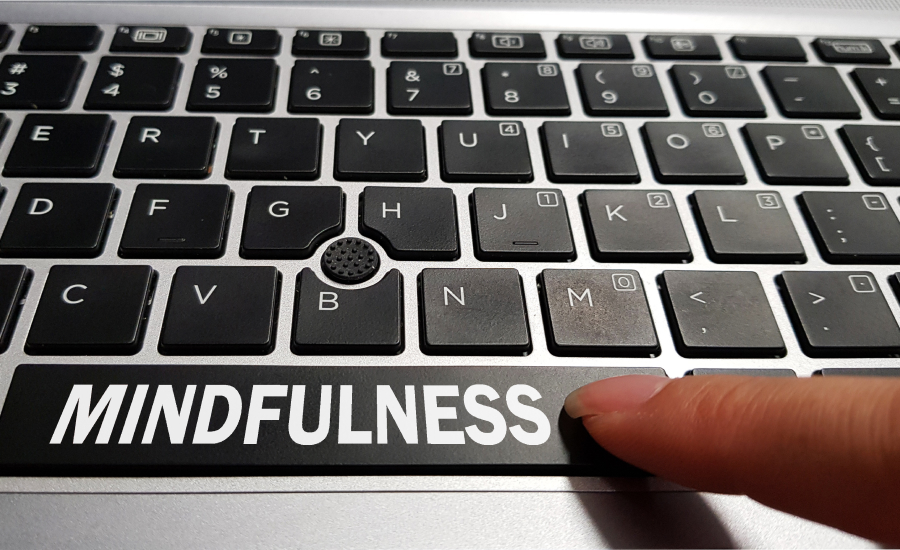Introduction
In this modern workplace culture, it has become increasingly important for us to focus on our mental health and well-being, alongside our professional responsibilities. One way that this can be achieved is by incorporating mindfulness and meditation into the workplace. This article will discuss the definitions and overview of mindfulness and meditation, the benefits of incorporating this practice into the workplace, and strategies for doing so.
Definition and Overview of Mindfulness and Meditation
The concept of mindfulness can be best defined as ‘the act of taking a moment to become aware of your thoughts and emotions in the present moment’, and is based on traditional Buddhist practice. Mindfulness can encompass intentional breathing, yoga, and guided contemplative practices, coming in a variety of forms and levels of complexity.
Meditation is often used interchangeably with mindfulness but is actually distinct. Meditation is a form of mental training that requires concentration and determination, in order to reach a state of relaxation and contentment. It involves the repetition of a particular meditation practice – such as focusing on a chosen object, repeating a mantra, or relaxing muscles – in order to clear the mind and relax the body.
Overview of the Workplace Environment
The workplace is a hive of hustle and bustle with hectic daily schedules, multiple projects, and higher-than-average stress levels, making it an ideal environment for the implementation of mindfulness and meditation. The rise in flexible working, remote working and the ‘always on’ culture has created a more complex workplace, challenging employees to remain focused and productive whilst facing distractions such as their phones and home lives.
Benefits of Mindfulness and Meditation in the Workplace

There are numerous benefits to employees that are derived from the regular practice of mindfulness and meditation in the workplace.
Increased Productivity
Regular mindfulness and meditation practice can help employees to stay focused and organized, resulting in increased productivity. The process of mindful meditation requires a high level of concentration and intention, teaching the mind how to handle stressful situations and improving its ability to switch between tasks. By using mindfulness, and practicing reflections or calming exercises, employees can be better equipped to manage their workloads, free from being overwhelmed by stress.
Improved Mental Health
Mental health is a growing concern in the workplace, and mindfulness and meditation offer an effective and holistic way to improve well-being and reduce stress. Numerous studies have demonstrated the mental health benefits of mindfulness and meditation, from improved anxiety and depression levels to improved self-esteem. Practicing mindfulness can help employees to become more aware of how they are feeling, allowing them to better manage their emotions and thoughts.
Enhanced Creativity
Mindfulness and meditation can help to stimulate creativity and problem-solving skills in the workplace. Regular mindfulness and meditation practice help the mind to become more open and flexible, allowing employees to think in a different way and come up with innovative solutions. This can often lead to increased motivation, productivity, and job satisfaction.
Reduced Stress Levels
Stress is a common issue in the workplace, with increased workloads and tight deadlines. Mindfulness and meditation offer a valuable tools to help reduce stress levels, with controlled breathing and relaxation techniques that help to bring the body back into balance. Through regular practice, employees can learn to become more aware of their stress levels, allowing them to take steps to reduce the intensity of their stress.
Improved Decision-Making Skills
Mindfulness and meditation provide a space for reflective thinking, enabling employees to make better decisions in the workplace. Through meditation, employees can be better equipped to weigh up the pros and cons of complex decisions, take a step back, and make choices that are based on the facts and their personal values.
Increased Job Satisfaction
Mindfulness and meditation offer employees an opportunity to check in with themselves and their work environment. It can help to improve employee job satisfaction by enabling employees to become more aware of their goals and how they can best achieve them, as well as allowing them to recognize when they have achieved success.
Better Team Communication & Collaboration
Mindfulness and meditation can help to enhance collaborative skills in the workplace through improved communication. By using mindful communication techniques, employees can become better equipped to listen to and understand their colleagues, resulting in greater collaboration and teamwork.
Strategies for Incorporating Mindfulness and Meditation into the Workplace Environment

Once the decision has been made to incorporate mindfulness and meditation into the workplace, it is important to consider how best to implement them. Here are some strategies to get started:
Designate a quiet place for mindful breaks or meditation sessions
It is important to create dedicated spaces in the workplace where employees can take a few mindful moments or meditation breaks. This could be in the form of a breakout space, a quiet corner, or an outdoor patio – whatever works best for the office layout. This will provide employees the opportunity to take regular breaks during the day, allowing them to step away from their desks and clear their minds.
Offer lunchtime mindfulness or meditation classes
Regular mindfulness classes or meditation sessions can be offered during lunchtime or after working hours, allowing employees to take part in guided meditation. This could be facilitated by internal or external coaches or could be as simple as a brief introduction to the basics of mindfulness and how to practice it.
Utilize mindfulness apps or websites to guide employees through guided meditation
There are now numerous mindfulness apps and websites available that can provide guided meditation sessions for employees. These can be accessible during lunch breaks, before starting the day, or even just for a few minutes during the day. This can assist employees in understanding the concepts of mindfulness and meditation more effectively, helping them to apply the principles to their working day.
Encourage employees to take regular mindful breaks throughout the day
It is important to encourage employees to take regular mindful breaks throughout the day, such as a few minutes of mindful breathing or a brief yoga session. This will help to keep employees focused and refreshed throughout the day, as well as enable them to be more mindful of their work-related decisions and processes.
Conclusion
In conclusion, incorporating mindfulness and meditation into the workplace can have numerous benefits, from increased productivity and improved mental health, to enhanced creativity and improved decision-making skills. By providing dedicated spaces for mindfulness and meditation, offering lunchtime classes, utilizing mindfulness apps and websites, and encouraging regular mindful breaks, employers can ensure that their employees are implementing mindfulness and meditation into their working day. This can ultimately lead to an overall increase in team job satisfaction and communication in the workplace.

